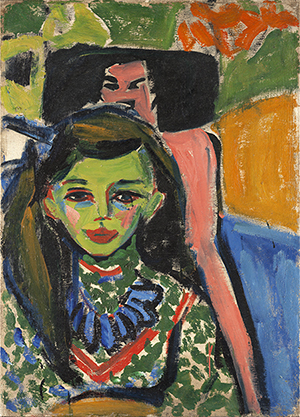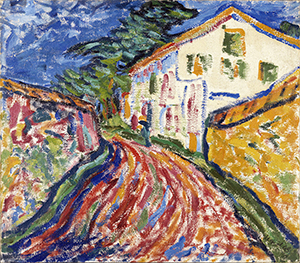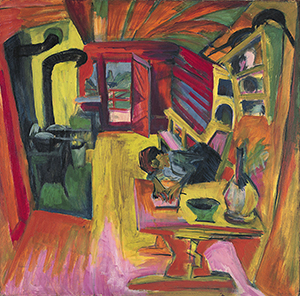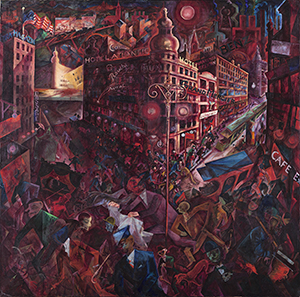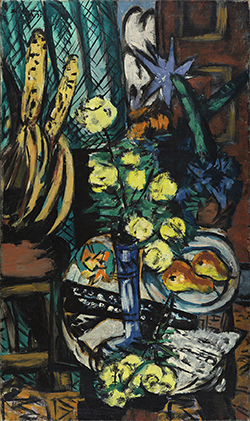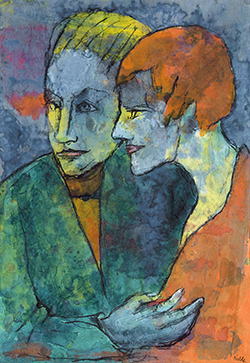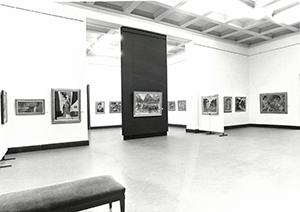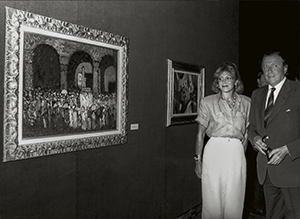Museo Nacional Thyssen-Bornemisza.
27 October 2020 - 14 March 2021
When in 1961 Baron Hans Heinrich Thyssen-Bornemisza acquired Young Couple by Emil Nolde he initiated a change of direction in the Thyssen family’s collecting activities. While his father Henrich Thyssen had assembled a remarkable collection of Old Masters during the interwar period, between the 1960s and 1990s Hans Heinrich would be extremely active as a collector of the principal 20th-century art movements, among which German Expressionism would occupy a pre-eminent place.
In 1993 the Spanish State acquired most of the Thyssen collection and the Museo Nacional Thyssen-Bornemisza thus came to house a significant representation of German Expressionism, a movement barely represented in Spanish collections. For the first time in decades the present exhibition, German Expressionism from the Baron Thyssen-Bornemisza Collection, reunites those works with the group of Expressionist paintings that remained with his wife, Carmen Thyssen-Bornemisza, and his children. In addition, it offers a new perspective on the paintings through a presentation that departs from their habitual chronological display in the galleries.
The exhibition, which is benefiting from the collaboration of Comunidad de Madrid, launches the commemoration at the Museum of the 100th anniversary of the birth of Hans Heinrich Thyssen-Bornemisza, which takes place in 2021. Next year will see other re-installations and thematic presentations of the Baron’s collection, including the North American paintings and a selection of works normally on long-term deposit from the Thyssen collection at the Museo Nacional de Arte de Catalunya, both scheduled for the autumn of 2021. In addition, a group of sculptures, paintings and examples of goldsmith’s works acquired by the Baron and now in the family collections will be on display from next spring.
German Expressionism from the collection of Baron Thyssen-Bornemisza is curated by Paloma Alarcó, Head of Modern Painting at the museum, who has articulated a new vision of the works structured around three concepts: the process of creation of the paintings; their early reception by critics and the public up to their condemnation by the Nazi regime and their subsequent rehabilitation in the post-war period; and the Baron’s relations with his dealers and the exhibition projects that he organised to promote his collection internationally.
The artists: creative processes and dissemination
I felt a different spirit in this art, a spirit of freedom that
totally broke away from the academic tradition.
The expressive brushstrokes and the anti-natural and contrasting colours of the German Expressionists immediately attracted Baron Thyssen’s eye. His interest initially focused on the work of the Dresden-based group Die Brücke [The Bridge] and subsequently on the members of the Blaue Reiter [Blue Rider], active in Murnau and Munich, as well as on other Expressionists working at the same time. All of them shared a way of understanding art that was based on an inner vision of the artist, replacing the imitation of reality with the invention of a new reality.
The members of Die Brücke aimed to extend a “bridge” between the essences of the German past and a utopian future, but also between life and art. For these artists the studio was a laboratory of new ideas and a space which they decorated with sculptures executed in a neo-primitive style, printed Batik fabrics and their own, handmade rustic furniture that reflected their aim of championing a pre-industrial and uncontaminated era. Also essential for this avant-garde movement was the relationship between man and nature, and landscape thus became their outdoor studio.
In the first section of the exhibition, entitled Studios, works such as Fränzi before a carved Chair (1910) and Kneeling Nude before a red Screen (1911-12) by Ernst Ludwig Kirchner or Before the red Curtain (1912) by Erich Heckel illustrate the key role of artists’ studios in their paintings. Outdoors, the third section, includes Summer in Nidden (1919-20) by Max Pechstein, Bridge in the Marsh(1910) by Emil Nolde, and Brick Factory(1907) by Erick Heckel. Between these two rooms is one devoted to cultural References, which displays works by the young Expressionists alongside Les Vessenots en Auvers (1890) by Van Gogh, Dusk (1888) by Munch, and Allées et venues (1887) by Gauguin with the aim of revealing the interest that these pioneers of modern art aroused among the German painters, who could have known their works through publications and at first hand from the exhibitions held in various cities in Germany. Van Gogh’s expression of internal emotions through colour, the exotic and primitive element in Gauguin’s work and his new, freedom-loving lifestyle, and Edvard Munch’s radical, existential Expressionism were some of the principal aspects that aroused their admiration. Max Pechstein recalled this years later: “With great pride we felt ourselves the bearers of a mission, artistically linked to the Dutchman Van Gogh and the Norwegian Edvard Munch.”
Of a much more mystical and symbolic type is the Expressionism of the Blaue Reiter artists: Wassily Kandinsky, Franz Marc, August Macke, Paul Klee, Lyonel Feininger, Alexei von Jawlensky and Johannes Itten, among others, who moved towards increasingly abstract ideas.
The connection between tradition and modernity through the abstraction of forms is one of the characteristics shared by many of these artists and is the focus of the exhibition’s next section, Popular Flavour, which includes Bagatelle no. 2 by Kandinsky (1915), Revolving House (1921) by Paul Klee, Galloping Hussars (1913) by August Macke, and The red Veil (1912) and Boy with a Doll (1910) by Jawlensky. Years later the latter would say: “My Russian soul was always close to old Russian art, to icons, Byzantine art, the mosaics at Ravenna, Venice and Rome and Romanesque art. All these artistic forms made my soul vibrate profoundly as in them I felt the true spiritual language.”
Most of these artists wrote manifestos and organised programmatic exhibitions as a means of disseminating their artistic ideas and they gradually gained some public and critical recognition. The next section, Diffusion, brings together some of the works that would eventually enter the Thyssen collection and which were included in the early Blue Rider collective and solo exhibitions, including View of a Square (1912) by Paul Klee, Painting with three Dots (1914) by Kandinsky, Circus (1913) by Macke, and Ships (1917) by Lyonel Feininger.
This growing public awareness of the Expressionists was interrupted by the outbreak of World War I. By around 1913 the original Die Brücke group had broken up and each artist pursued his own direction: Macke and Marc died at the front, Kandinsky returned to Russia, and Jawlensky took refuge in Switzerland. In the following decade and while some of the group’s members such as Feningner, Itten, Kandinsky and Klee moved to Weimar then to Dessau to work at the Bauhaus, others such as Grosz and Beckmann visually reflected the internal fragmentation of German society in their work, introducing a powerful allegorical element and an acerbic sarcasm into their paintings.
Politics: persecution and stigmatisation
For me, the fact that these artists had been oppressed by the National Socialist regime and their art officially labelled degenerate was an additional spur to collecting them.
The Expressionists captivated Baron Thyssen due to their colour and expressive force but also for political reasons. For the Baron, collecting was a way of rescuing the memory of a painting and of saving it from the threat of oblivion.
From the time of Hitler’s rise to power the National Socialist regime implemented a strategy of artistic purging, organising various exhibitions that condemned the artists selected for inclusion, of which Entartete Kunst (Degenerate Art) is the one that has acquired most resonance in the history of 20th-century art. It opened in Munich, the Nazi capital, in July 1937 and travelled to other German cities.
A number of paintings now in the Thyssen collections which were at that period in the collections of German museums were confiscated and derided by the Nazis. The most notable among them is undoubtedly Metropolis (1916-17) by George Grosz. Acquired in 1924 by the Mannheim Kunsthalle, it was seized and included in Entartete Kunst in 1937. Written above Grosz’s paintings was the phrase “Art as a tool of Marxist propaganda against military service.”
While the exhibition was still touring, the Nazi regime decided to sell some of the confiscated works to raise funds for the war. This led to the sale of Nolde’s Summer Clouds (1913) and Erich Heckel’s Portrait of Siddi Heckel (1913). They were subsequently acquired by Baron Thyssen and can now be seen together in this section of the exhibition.
Art dealers: rehabilitation and recovery
After World War II the Expressionists were almost immediately rehabilitated. The early postwar period witnessed an intensive endeavour to reinstate modern German art with the aim of compensating for the adversities it had experienced under Nazism. German museums once again acquired works by this movement and increasing numbers of publications and exhibitions reinstated its positive image in German public opinion. The first exhibition that aimed to revive the memory of Die Brücke was organised in 1948 at the Kunsthalle in Berne but the most important was the major retrospective held at the Museum Folkwang in Essen in 1958. Among the works on display were six oils that subsequently entered the Thyssen collection, including Fränzi before a carved Chair and Doris with Ruff Collar (ca.1906) by Kirchner, and Sun over a Pine Forest (1913) by Karl Schmidt-Rottluff.
Ketterer guided me in my discovery of Expressionism. Kirchner became my favourite artist and Ketterer was his executor, so I was close to the source. When Ketterer needed money he sold me something from his own collection. I always chose one of the best pieces, and he resisted [...] he told me that every time it hurt like losing part of himself.
Baron Thyssen’s first contact with Expressionist art was through the Stuttgarter Kunstkabinett, an auction house owned by Roman Norbert Ketterer which since its opening in Stuttgart in 1946 at the start of the postwar era had been a pioneer in the promotion and sale of modern German and international art, characterised by its firm commitment to reinstating the names of artists classed as “degenerate” by the Third Reich. Ketterer, who moved his headquarters in 1962 to Campione d’Italia, very close to the Villa Favorita, became a good friend of the Baron and was his principal source of Expressionist paintings between 1961 and 1987.
It should be noted that Baron Thyssen began to acquire German Expressionist paintings at the very outset of their reassessment and that his collecting activities significantly contributed to their critical rehabilitation. Nolde’s The young Couple (1931-35), his first purchase from Ketterer in May 1961, was followed by other paintings that same year, including House in Dangast (1908) by Heckel and Horse Fair (1910) by Pechstein, totalling around thirty paintings acquired from this dealer in successive years. Kirchner’s The Bay (ca.1914) would be Ketterer’s last sale to the Baron in 1987. During those years Baron Thyssen also worked with other dealers in 20th-century German art such as Leonard Hutton, from whom he acquired The Dream (1912) by Franz Marc and works by other Blaue Reiter artists.
For years I had unsuccessfully tried to find an important work by Franz Marc on the market. My persistence finally paid off when I was able to buy The Dream of 1913 from Leonard Hutton in New York. Hutton is another dealer who deserves praise for giving the German Expressionists the place they deserve.
As a collector Baron Thyssen was interested in the history of the paintings he acquired and was particularly attracted to emblematic works that had a memorable past, of which The Dream is undoubtedly the best example. Franz Marc gave his painting to his fellow artist Kandinsky soon after he finished it. During the time it was in Russia from 1914 to 1921 it remained in the care of Gabriele Münter and on the express desire of the painter’s widow, Maria Marc, it was included in the exhibition held in Munich and Weisbaden in 1916 which commemorated Marc’s death. Years later it was selected for inclusion in the International Exhibition of Modern Art organised by the Société Anonyme and held in New York and other American cities in 1926 and 1927. At the time the Baron purchased it, it still belonged to Kandinsky’s second wife Nina.
The exhibition’s catalogue recounts a large number of these minor or significant stories that lie behind each of the paintings and which have been unearthed through meticulous research that has revealed the details of the works’ “biographies” before and after they were acquired by the Baron.
The collection: a global image / Internationalisation
I began to think that if the early years of the 20th century had produced so many important things in science, technology and other fields, then the art of that period also had to be interesting. [...] My attitude to modern art has changed since then. The contact between the viewer and the object is totally different to that in earlier art. You feel bombarded by effects that produce a nervous stimulus comparable to modern music. Furthermore, modern art allows the viewer more interpretative possibilities which encourage a feeling of greater freedom.
After inheriting most of his father’s collection following his death in 1947, Baron Thyssen began to acquire paintings with the intention of continuing his activities and for fifteen years he only collected Old Masters. In late 1950, however, he started to feel uncomfortable with the ideas he had inherited from his father, who dismissed modern art. The Baron’s discovery of German Expressionism and his first acquisitions of works by Kirchner, Nolde, Kandinsky and Marc led him to become interested in the major 20th-century art movements, giving rise to an intense focus on collecting works by the avant-gardes during the following decades.
Aside from the undeniable passion for art that always guided his attitude to collecting, Hans Heinrich Thyssen also aimed to create a global image for the collection with a clear emphasis on public access. With this aim in mind, in 1960 he initiated an extremely active international exhibition programme in order to present the different facets of his encyclopaedic collection. This policy of international expansion distanced him from the previous German nationalism that had guided his father and identified him with the values of the new non-aggressive, more modern and international Germany.
While some of the Baron’s early German Expressionist acquisitions were included in these international exhibitions on modern art, the first and only monographic one devoted to this part of the Thyssen collection opened at the Villa Favorita in Lugano in 1989 before travelling to Washington, Fort Worth and San Francisco the following year. On that occasion The Ludwigskirche in Munich (1908) by Wassily Kandinsky, which was the front cover image for the accompanying catalogue, was displayed alongside a selection of German Expressionist masterpieces from the Baron’s collection that can once again be seen together in this final section and in the rest of the exhibition, completing this new perspective on the collection.
Exhibition Details
Title: German Expressionism from the collection of Baron Thyssen-Bornemisza.
Organiser: Museo Nacional Thyssen-Bornemisza.
With the collaboration of: Comunidad de Madrid.
Date and venues: Madrid, Museo Nacional Thyssen-Bornemisza, 27 October 2020 to 14 March 2021.
Curator: Paloma Alarcó, Head of Modern Painting at the Museo Nacional Thyssen-Bornemisza.
Number of works: 80
Publications: Catalogue with texts by Guillermo Solana, Paloma Alarcó, Juan Ángel López-Manzanares and Leticia de Cos.
